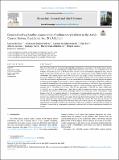Por favor, use este identificador para citar o enlazar a este item:
http://hdl.handle.net/10261/318667COMPARTIR / EXPORTAR:
 SHARE SHARE
 CORE
BASE CORE
BASE
|
|
| Visualizar otros formatos: MARC | Dublin Core | RDF | ORE | MODS | METS | DIDL | DATACITE | |

| Título: | Demersal and epibenthic communities of sedimentary habitats in the Avilés Canyon System, Cantabrian Sea (NE Atlantic) |
Autor: | Modica, Larissa CSIC ORCID; Rodríguez-Cabello, Cristina; Rodríguez, Augusto; Ríos, Pilar; Serrano, Alberto; Parra-Descalzo, Santiago; Gómez-Ballesteros, María; Arrese-González, Beatriz; Sánchez, Francisco | Palabras clave: | Centro Oceanográfico de Gijón Avilés canyon system Medio Marino Soft bottom assemblages Benthic communities Natura 2000 Cantabrian sea |
Fecha de publicación: | 30-sep-2022 | Citación: | Estuarine, Coastal and Shelf Science, 275. 2022: 1-14 | Resumen: | The aim of this study was to describe the epibenthic and demersal communities of the Avilés Canyon System (ACS) in relation to the environmental variables that characterize their biotope. ACS (Cantabrian Sea, NE Atlantic) was recently included in the Natura 2000 network as a Site of Community Importance (SCI). Data of faunal biomass derived from 6 surveys carried out using beam trawl and otter trawls in 2009 and 2010 within INDEMARES and ERDEM projects. Data were divided into two groups to obtain information about the two ecological compartments: benthic and demersal. The total number of species used in this analysis ascended to 116 in the case of benthic organisms and 110 in the case of demersal. Hierarchical clustering analysis was applied to obtain groups of samples similar in terms of species composition for the two ecological components. Depth was the main discriminating factor for grouping hauls, showing high consistency of bathymetric range independently from the compartment examined. Six groups were identified by depth as follows: medium shelf (∼100–200 m), external shelf (∼150–300m), shelf break (∼300–400 m), upper-slope (∼500–700 m), upper middle-slope (∼700–1100 m), and lower-middle-slope (1200–1500 m). SIMPER analysis on biomass values was performed to determine the structure of the faunal assemblages observed for each group in both compartments. Using biomass values for the analysis allowed for the exploration of groups playing important roles in ecosystem functioning and energy fluxes taking place on the sedimentary bottom of this SCI. Finally, CCA analysis revealed that the main environmental drivers were depth, broad scale bathymetric position index (BPI), near-bottom salinity, sedimentary type, and dynamics related variables (Q50 phy and So). This study gives an inventory of the soft bottom assemblages along a very wide depth range (100–1500 m) inside a SCI, linking both epibenthic and demersal communities with the biotope preferences. This study contributes to fundamental knowledge on soft-bottom communities as a pre-requisite, necessary for the next steps in terms of management framework in the SCI. | URI: | http://hdl.handle.net/10261/318667 | DOI: | https://doi.org/10.1016/j.ecss.2022.107966 | ISSN: | 0272-7714 |
| Aparece en las colecciones: | (IEO) Artículos |
Ficheros en este ítem:
| Fichero | Descripción | Tamaño | Formato | |
|---|---|---|---|---|
| Modica_etal_communitiesSCA_2022.pdf | Artículo principal | 8,79 MB | Adobe PDF |  Visualizar/Abrir |
CORE Recommender
Page view(s)
18
checked on 21-may-2024
Download(s)
34
checked on 21-may-2024
Google ScholarTM
Check
Altmetric
Altmetric
Este item está licenciado bajo una Licencia Creative Commons

